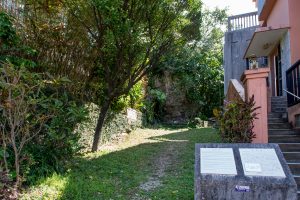Kyō Ahagon Jikki, the sword and karate
In 1522, Nakasone Toyomiya Genga of Miyako donated a treasured sword to the king (1). As the king’s guardian sword, it was named Jiganemaru (2).
Kyō Ahagon Jikki, (birth and death dates unknown) was entrusted with King Shō Shin’s precious sword and travelled to Kyōto to have it examined. In Kyōto, he contracted a sword sharpener and after the task was completed, he successfully brought the treasured sword back to the king.
However, it turned out that the sword that he brought back was replaced for another one by the sword sharpener. So fine was the Jiganemaru that it raised the desire of the sharpener. Realizing that the sword he brought back to Ryūkyū wasn’t the original one, Kyō Ahagon returned to Kyōto. After three years of search for the sword, he finally found it and succeeded in bringing it home safely.
The king was delighted and gave Kyō Ahagon many rewards. The fame of Kyō Ahagon’s bravery increased more and more. The more the fame rises, the more people would envy him until they were finally able to attract the attention of the king. As he could not punish Kyō Ahagon on false charge, the king invited him to the court room for a chat, offering him some tea. After a while, a young man looking for an opportunity moved forward and stabbed Kyō Ahagon with a dagger.
This story is written in the book “Kyūyō”, retracing the history of the Ryūkyū. In the part depicting the episode, it is written as follow. “He broke the youth’s femora (3) using karate (4)”. While it is unclear if karate was studied as a martial art, at that time, Chinese were already established in the Ryūkyū. Furthermore, since 1372, tribute trade was actively being held, it can be imagined that Chinese martial arts influences on the local art of Tī were happening. All this make this record quite interesting.
Episodes about Kyō Ahagon can also be found in the books “Ryūkyū Yūraiki” (1713) and “Ryūkyū koku Kūki” (1731).
It is unknown if the historical figure Kyō Ahagon Jikki was a disciple of karate. Yet, his grave is still preserved in Shuri. It is located in Shuri Samukawa, behind the Mezura Dake – peak.
Source: Okinawa Karate no Teihon (Unpublished resource compiled by Tsuha Kiyoshi as ordered by the now terminated Okinawa Karatedō kobudō Support Center)
(1) Most likely it is King Shō Shin who was on the throne between 1477 till 1526.
(2) The Jiganemaru is preserved at the Naha City Historical Museum. A photo is available at this link.
http://www.rekishi-archive.city.naha.okinawa.jp/archives/item1/2059
(3) In the Japanese text, “Mata” could also be translated in “the crotch, the thigh, the groin”.
(4) In the Japanese text, karate is written “open hand”.

